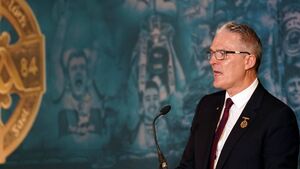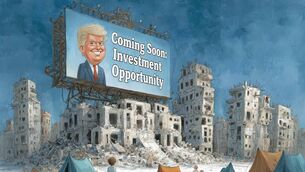Can the GAA grasp nettle of rural decline?

GAA President Jarlath Burns addresses the GAA's National Congress in the Abbey Hotel, Donegal, last month. Picture: INPHO/Leah Scholes
- Jarlath Burns, President of the GAA, Friday, February 21
It is refreshing to see the GAA waking up to the full reality of the problem of rural depopulation and appreciate what they can do about it.
It is not before time and the words of the association’s president should be a clarion call throughout the organisation – this is not something that may happen in the future. It is happening now, has been happening for sometime and is transforming for the worse the whole fabric of the organisation.
It’s not just a GAA problem but a societal one and the impact on the GAA, with a footprint in virtually every parish in the country, is particularly pronounced and instructive.
Rural depopulation represents an existential threat to the GAA and to the Ireland many of us know and love, a huge part of the fabric of our society.
It is, as we have said, not a new problem. It has been flagged throughout the country by clubs in rural areas and by the media for many years. But only now have we seen the GAA, in the guise of its president, truly appear alarmed and seeking to do something substantial about it.
Burns is right – the GAA has a powerful voice that can be used on this issue. The organisation has always tried to stay away from politics but this issue is so interlinked with its own future prosperity that to ignore it would be a dereliction of duty.
Counties like Mayo have been far too quiet on this subject. They should be sounding the alarm and fighting for their constituent clubs who are on the brink and for those heading in that direction.
Burns’s appreciation of the extent of the problem comes arguably too late for clubs like Kilfian and Lacken, who have merged as a co-operation as Northern Gaels with a permanent amalgamation almost inevitable. Other clubs in Mayo are also too far down the road, too sorely impacted by depopulation to be able to stop the inevitable.
The time for action isn’t now – it was a generation ago. But it is a case of better late than never, as frustrating as that will be for clubs whose numbers have fallen too far.
Talk and action need to be strong and swift before more and more clubs, more and more communities face a similar fate. Because population numbers clearly illustrate the bleak future for many clubs.
The Belmullet Electoral Area (Erris, Achill and Mulranny) currently has 1,073 children in its 25 national schools. Go back over 30 years to 1994 when the Celtic Tiger was just starting to roar and the population of the schools in the area was almost double – 2,135.
Drill in deeper and you will see the parish of Kiltane has just one-third of national school children now compared to 1994 (down from 336 to 112). Go across the top of North Mayo and you will see similar stories, similar steep drop-offs in school-going children in parishes like Ballycastle, Lacken, Kilfian and Moygownagh.
The overall census figures might not reflect as sharp a drop but the number of children in a community represents the best indicator of the long-term viability not just of the local GAA club but of the community at large.
It hasn’t happened overnight, it has been a gradual, slow bleed of numbers.
Benny Hurl is the Chairperson of the GAA’s National Demographics Committee. Indeed, he was one of Jarlath Burns’ first appointments after he became GAA President. He and his committee have been very busy and Hurl has been very vocal and articulate in highlighting the extent of the problem nationally. It would appear his calls are being heard.
He and his committee have a three-thronged approach moving forward. They plan to work with demographics officers in each county board to get a better understanding of the situation in each county. They plan to give a suite of bespoke options that counties can choose from that suit their needs best. One option is around player eligibility where players may be able to play with struggling clubs if they have a familial connection there.
Parentage rules have been in vogue at elite inter-county for some time. With numbers there never an issue, it shows the misplaced focus of the GAA. Only now are they seeing the importance of parentage rules in the most pressing area – at club level for clubs who are struggling to field.
The next approach by the committtee is by some distance the most important and that is on a political level. Increased Government engagement and lobbying to highlight demographic problems in rural Ireland (and also, the reverse of the coin, in urban Ireland).
The causes and effects of rural depopulation are there to be seen by all of us. Poor spatial strategy is, arguably, the largest root cause.
Majorly imbalanced regional development – with our economy among the most centralised towards its capital across the entire European Union – means that employment opportunities not just in rural areas but across entire regions like the Northern and Western Region (Connacht combined with Cavan, Monaghan and Donegal) are greatly diminished. Our region is a ‘lagging’ region by EU terms, with a GDP of just 71% of the EU average.
Emigration and migration from our region are happening for generations and the main reason is the lack of employment. It leads to smaller schools, schools closing, shops, garda stations, post offices etc all following in their wake.
The hollowing out of rural areas impacts the GAA clubs probably half a generation later as the grá for home means many players will still commute long distances to play for their club but the reality is that their offspring will not.
Urbanisation is the second part of that dynamic. Even within Mayo itself, population numbers have grown in towns like Castlebar, Claremorris and Ballinrobe.
It was perplexing to hear Burns say that while there is an issue with rural depopulation in North Mayo, there are ‘plenty of jobs’, equating the issue to be a ‘lifestyle choice’.
The reality is that fewer people leave Castlebar, Claremorris and Ballinrobe, as well as outlying rural areas, than Ballina and rural parts of North Mayo because of the reality of imbalanced regional development, even within our ‘lagging region’. Employment opportunities locally as well as relative proximity to Galway City make those communities more viable than in North Mayo where Ballina and, regionally, Sligo do not have the same draw for employment.
But we should not be too semantic when a president of the GAA is speaking passionately and forcefully about such a vital topic.
It is getting harder and harder to build or buy in rural Ireland. There is a debate to be had about one-off rural housing and a debate to be had about vacant homes. But overriding all of that ought to be the wider question of what we want as a society.
Do we want to keep accelerating towards urban living or do we wish to maintain viable rural communities, which have been a huge part of our history?
There seems to be a massive movement behind the latter but without a radical change in political outlook and spatial strategy, we will be having this discussion again and again while more and more GAA clubs and communities go to the wall.
There needs to be greater incentives for providing employment away from cities and, dare we say it, decentralisation of government departments. There needs to be greater investment in infrastructure in parts of our country, such as Mayo, which have been left behind for far too long. Road, rail, airport and broadband. Front-loaded investment – build it and they will come.
Housing and generally making communities engaging places to live are vital too but should be easier with a critical mass of population.
And with Dublin and many urban areas creaking at the seams, a change in spatial strategy makes sense on so many levels.






